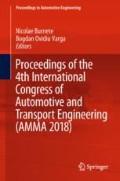Abstract
Hybrid composite specimens out of basalt and flax fibers reinforced with a cyanate-ester and epoxy resin combination were subjected to cone evaluation in a cone calorimeter. The increase of the BF layers within the hybrid architectures significantly decrease the pHRR and CO/CO2 released content but not the residues at the end of the combustion process. On the other hand, flax fiber reinforced composites ignite earlier, release a relatively high amount of heat and leaves reduces residues at the end of the combustion process. Further studies on fire-retardant additives deployment within these hybrid structures are expected to boost the flammability outcomes.
Access this chapter
Tax calculation will be finalised at checkout
Purchases are for personal use only
References
Petrella, R.: The assessment of full-scale fire hazards from cone calorimeter data. J. Fire Sci. 12(1), 14–43 (1994)
Schartel, B., Hull, T.: Development of fire-retarded materials—interpretation of cone calorimeter data. Fire Mater. 31, 327–354 (2007)
Patel, P., Hull, T., Lyon, R., Stolariov, S., Walters, R., Crowley, S., Safronava, N.: Investigation of the thermal decomposition and flammability of PEEK and its carbon and glass-fiber composites. Polym. Degrad. Stab. 96, 12–22 (2011)
Kruger, H., Focke, W., Mhike, W., Taute, A., Robertson, A., Ofosu, O.: Cone calorimeter study of polyethylene flame retarded with expandable graphite and intumescent fire-retardant additives. J. Fire Sci. 32(6), 498–517 (2014)
Chapple, S., Anandjiwala, R.: Flammability of natural fiber-reinforced composites and strategies for retardancy: a review. J. Thermoplast. Compos. Mater. 23(6), 871–893 (2010)
Chai, M., Bickerton, S., Bhattacharyya, D., Das, R.: Influence of natural fiber reinforcements on the flammability of bio-derived composite materials. Compos. B 43, 2867–2874 (2012)
El-Sabbagh, A., Steuernagel, L., Ziegmann, G., Meiners, D., Toepfer, D.: Processing parameters and characterization of flax fiber reinforced engineering plastic composites with flame retardant fillers. Compos. B 62, 12–18 (2014)
Dasari, A., Yu, Z., Cai, G., Mai, Y.: recent developments in fire retardancy of polymeric materials. Prog. Polym. Sci. 38, 1357–1387 (2013)
Jeencham, R., Suppakarn, N., Jarukumjorn, K.: Effect of flame retardands on flame retardant, mechanical and thermal properties of sisal fiber/polypropylene composites. Compos. B 56, 249–253 (2014)
Subasinghe, A., Bhattacharyya, D.: Performance of different intumescent ammonium polyphosphate flame retardants in PP/kenaf fiber composites. Compos. A 65, 91–99 (2014)
Kandare, E., Luangtriratana, P., Kandola, B.: Fire reaction properties of flax/epoxy laminates and their balsa sandwich composites with or without fire protection. Compos. B 56, 602–610 (2014)
Motoc Luca, D., Ferrandiz Bou, S., Balart, R.: Thermal properties comparison of hybrid CF/FF and BF/FF cyanate ester-based composites. J. Therm. Anal. Calorim. https://doi.org/10.1007/s10973-018-7222-y
Author information
Authors and Affiliations
Corresponding author
Editor information
Editors and Affiliations
Rights and permissions
Copyright information
© 2019 Springer Nature Switzerland AG
About this paper
Cite this paper
Luca Motoc, D., Ionut Sava, G. (2019). A Comparison Approach to Fire Retardancy Behavior on Tailored Hybrid BF/FF Cyanate-Epoxy Composites. In: Burnete, N., Varga, B. (eds) Proceedings of the 4th International Congress of Automotive and Transport Engineering (AMMA 2018). AMMA2018 2018. Proceedings in Automotive Engineering. Springer, Cham. https://doi.org/10.1007/978-3-319-94409-8_41
Download citation
DOI: https://doi.org/10.1007/978-3-319-94409-8_41
Published:
Publisher Name: Springer, Cham
Print ISBN: 978-3-319-94408-1
Online ISBN: 978-3-319-94409-8
eBook Packages: EngineeringEngineering (R0)

